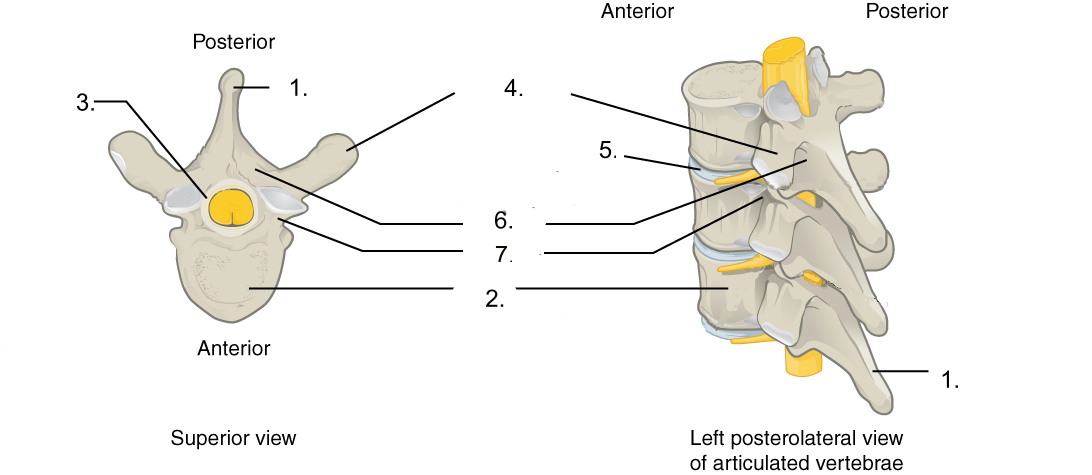Thorax
Chapter Conclusion
Learning Objectives
- Understand what the thoracic cage is and the components of it (ribs, sternum, etc).
- Be able to identify the cervical, thoracic, lumbar, and sacral vertebrae that make up the vertebral column and their unique feature (refer to head and neck, abdominal, and pelvis sections for additional vertebrae information).
- Understand the actions, origins & insertions, and nerve innervations of the Erector Spinae muscles.
- Identify to 5 major ligaments in the vertebral column and know their action and position.
- Know what the mediastinum is, how blood flow is organized to and from the heart, and anatomy fo the heart.
- Develop a general understanding of some of the clinical conditions in the Thorax region.
Check Your Understanding
Part A.
1. Ribs 1-7 are considered __________ ribs and attach directly to the sternum via __________.
a) true, costal ligaments
b) false, costal cartilage
c) floating, costal ligaments
d) true, costal cartilage
2. Cervical vertebrae contain the following features:
a) small bodies, bifid spinous process, & no costal facets
b) small bodies, long slender spinous process, & have costal facets
c) heart shaped bodies, bifid spinous process, & no costal facets
d) heart shaped bodies, long slender spinous process, & have costal facets
3. Thoracic vertebrae contain the following feature:
a) small bodies, bifid spinous process, & no costal facets
b) small bodies, long slender spinous process, & have costal facets
c) heart shaped bodies, bifid spinous process, & no costal facets
d) heart shaped bodies, long slender spinous process, & have costal facets
4. The erector spinae muscle that connects the tips of spinous processes and is the most medial is:
a) Longissimus
b) Spinalis
c) illiocostalis
d) Scalene
5. Which of the following is not a characteristic that all vertebrae contain?
a) pedicles
b) vertebral arch
c) laminae
d) costal facets
e) vertebral foramen
6. Complete the statement.
_________&__________ are ________ curves and are __________ birth.
a)Cervical & lumbar vertebrae, secondary, present
b) Cervical & lumbar vertebrae, secondary, absent
c) Thoracic & sacral vertebrae, primary, absent
d) Thoracic & sacral vertebrae, primary, present
7. Which of the following layers of the heart is most superficial?
a) myocardium
b) epicardium
c) endocardium
D) pericardial cavity
8. Scoliosis can best be described as:
a) Upper and lower back pain
b) lateral spinal curvature distortion
c) excessive spinal curvature that causes the back to appear “hunched”
d) none of the above
9. Which of the following is not one of the 5 ligaments that help stabilize the vertebral column?
a) infraspinous ligament
b) supraspinous ligament
c) interspinous ligament
d) ligament flava
10. Which of the following is the most inferior part of the sternum?
a) body
b) manubrium
c) xiphoid process
d) sternal end
Part B.
Match the definition to the correct statement. Answers may only be used once. There may be extra definitions.
| Statements | Definitions |
| 1. The _______________ of the mediastium contains the anterior, posterior, and middle divisions.
2. ______________ have short, blunt spinous processes. 3. The _____________ is situated within the vertebral canal, and limits flexion of the vertebral column and reinforces the intervertebral discs. 4. The largest artery in the body is the ______________. 5. There are 12 ____________ in the vertebral column. 6. The __________ is the receiving chamber for blood in the heart. 7. The ____________ controls voluntary and involuntary skeletal muscle contractions. 8. The ____________ runs down the ventral surface of the spine and helps stabilize the spine. 9. The pumping chambers of the heart at called ___________ and send blood away from the heart. 10. The ___________ of the mediastium contains the trachea, esophagus, and great vessels related to the heart.
|
a. thoracic vertebrae
b. sacral vertebrae c. cervical vertebrae d. lumbar vertebrae e. anterior longitudinal ligament f. posterior longitudinal ligament g. somatic nervous system h. autonomic nervous system i. superior region j. inferior region k. thoracic aorta l. abdominal aorta m. atria n. ventricles
|
Part C.
For the following questions, properly identify the components in the diagram. Each answer will be used once.

| Questions | Features |
|
|
A. transverse process
B. vertebral body C. pedicle D. spinous process E. lamina F. intervertebral disc G. vertebral foramen |
Answer key
Part A.
1) d 2) a 3) d 4) b 5) d 6) d 7) b 8) b 9) a 10) c
Part B.
1) j 2) d 3) f 4) k 5) a 6) m 7) g 8) e 9) n 10) i
Part C.
- D 2. B 3. G 4. A 5. F 6. E 7. C

